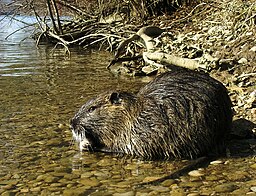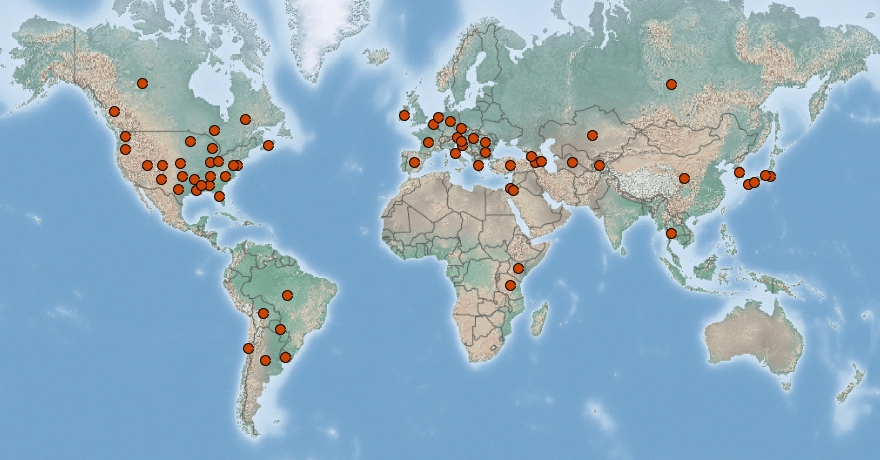 |
Coypu | Status LU: casual. 1st record: 1954. |
 |
Biwerrat | Status Eur.: established. IAS of Union concern (2016). |
 |
Ragondin | RA: ISEIA: A1, Black List. Harmonia+: 0,33 |
 |
Nutria | Wikipedia:     | Wikispecies: | Wikispecies:  | CABI | CABI |
 |
Beverrat | Back to the list of vertebrates |
Contents
Report the species
→ Report Myocastor coypus to the National Museum of Natural History.
Brief description
Myocastor coypus (Molina, 1782) is a large, herbivorous, semiaquatic rodent. The coypu lives in burrows alongside stretches of water, and feeds on river plant stems. Originally native to subtropical and temperate South America, it has since been introduced to North America, Europe, Asia, and Africa, primarily by fur farmers (Wikipedia contributors 2019).Overgrazing by nutria causes the local extinction of aquatic plants and the destruction of reedbeds and fish nursery areas. Due to its burrowing activity, it degrades river banks and affects river flow. Rare marshbirds are affected by nest destruction, egg predation or habitat destruction. Nutria could also act as a reservoir for different pathologies and cause damage to agriculture. Nutria is included in the appendix under the recommendation no 77 of the Council of Europe as a species which has proved to be a threat to biological diversity and for which eradication is strongly recommended (Branquart et al. 2013).
IAS of Union concern
In 2016, Myocastor coypus (Molina, 1782) was added to the list of invasive alien species of Union concern (Anonymous 2016) which implies that member states shall take all necessary steps to prevent it’s unintentional introduction or spread.
Status and distribution in Luxembourg
Records of Myocastor coypus Molina, 1782 in Luxembourg. Data source: Recorder-Lux, iNaturalist & GBIF, 2025-12-04.
Myocastor coypus was first documented in Luxembourg in February 1954 near the Alzette river in Hunsdorf, Municipality of Lorentzweiler (Heuertz 1957: 50).
A few years ago, it was only observed sporadically in Luxembourg and could not manage to establish (Schley & Herr 2009: 170). In 2024, already 96 observations have been documented in the national database , two thirds of them since 2020 (MNHNL, iNaturalist & GBIF 2024) .
On 19th September 2017, a forester captured a coypu in Osweiler (commune of Rosport, eastern Luxembourg) and put it to sleep. This detection of an IAS of Union concern (Anonymous 2016) was notified to the Luxembourg authorities on 26 September 2017 and an Eradication Measure Set was also submitted on 26 September 2017, pursuant to Article 17(1) of R. 1143/2014 (Anonymous 2014).
Since then, the species was observed on regular basis in Luxembourg. It has to be considered as established at least in the Haff Réimech area. Because of its occurrence in the bordering regions of France (Chiers, Moselle) and Germany (Saar), it is likely that the species will continue to populate national watercourses (Becker-Krüll & Schaefer 2013).
Management
Action plan
An action plan for the species has been published in 2020:
→ Finalised Action Plan for Myocastor coypus (De Sousa 2020)
Risk assessment
ISEIA protocol
A1 (3+3+2+3) = Black List, reassessed on 25 October 2019 by C. Ries & M. Pfeiffenschneider. First assessed as C0 (3+2+1+1) (Ries et al. 2014: 199).
Harmonia+ protocol
Overall risk score 0,33 = (Overall Invasion score 0,48 x Overall Impact score 0,67) (evaluated by Sandra Cellina, Jan Herr and Manou Pfeiffenschneider).
 Invasion
Invasion0,67

 Impact
Impact0,33

 Risk
RiskWorldwide distribution
Fact sheet
PDF fact sheet of the Nature and Forestry Administration: FR | DE
Bibliography
- Anonymous, 2014. Regulation (EU) No 1143/2014 of the European Parliament and of the Council of 22 October 2014 on the prevention and management of the introduction and spread of invasive alien species. Official Journal of the European Union 4.11.2014 L 317: 35-55.
- Anonymous, 2016. Commission implementing regulation (EU) 2016/1141 of 13 July 2016 adopting a list of invasive alien species of Union concern pursuant to Regulation (EU) No 1143/2014 of the European Parliament and of the Council. Official Journal of the European Union L 189: 4-5.
- Becker-Krüll, L. & P. Schaefer, 2013. Jagdbare Wildtierarten Luxemburgs. Administration de la nature et des forêts, Luxembourg, 96 pp.
- Branquart, E., M. D’aes, B. Manet, G. Motte, V. Schockert & J. Stuyck, 2013. Harmonia database: . Harmonia version 1.2, Belgian Forum on Invasive Species. URL: http://ias.biodiversity.be [accessed on 2019-10-25]
- CABI, 2008. Myocastor coypus (Molina, 1782) [original text by Dr. Sandro Bertolino & IUCN/SSC]. In: Invasive Species Compendium. Wallingford, UK: CAB International. URL: www.cabi.org/isc [accessed 2019-11-22]
- De Sousa, T., 2020. Plan d’action pour espèces exotiques envahissantes au Grand-Duché de Luxembourg: le Ragondin, Myocastor coypus (Molina, 1792). Version 2020-09-04. Administration de la nature et des forêts, Luxembourg. 21 pp.
- Heuertz, M., 1957. Premières captures de rats musqués (Ondatra zibethicus L.) au grand-duché de Luxembourg. Archives de la section des sciences de l’Institut grand-ducal N.S. 24: 41-51.
- MNHNL, 2000-. Myocastor coypus (Molina, 1782) in Recorder-Lux, database on the natural heritage of the Grand Duchy of Luxembourg. Musée national d’histoire naturelle, Luxembourg. URL: https://mdata.mnhn.lu [Accessed 2020-02-04]
- MNHNL, iNaturalist & GBIF, 2019. Myocastor coypus (Molina, 1782) in MNHNL-mdata, online portal combining species observation from Recorder-Lux, iNaturalist and GBIF. National Museum of Natural History, Luxembourg. URL: https://mdata.mnhn.lu [Accessed 2020-02-04]
- Pir, J.B. & L. Schley, 2015. Développement des connaissances sur la répartition et l’écologie des mammifères au Luxembourg entre 1990 et 2015. Bull. Soc. Nat. luxemb. 116: 437-455.
- Ries, C., M. Pfeiffenschneider, Engel, E., J.-C. Heidt & M. Lauff, 2014. Environmental impact assessment and black, watch and alert list classification after the ISEIA Protocol of vertebrates in Luxembourg. Bull. Soc. Nat. luxemb. 115: 195-201. [PDF 247 KB]
- Schley, L., C. Schanck, M. Schaul & C. Sinner, 2001. Neubürger und Heimkehrer unter den Wildtieren Luxemburgs. Beiträge zur Jagd- und Wildforschung 26: 141-154.
- Schley, L. & J. Herr, 2019. Säugetiere Luxemburgs. Hrsg.: natur&ëmwelt a.s.b.l., Ministère du développement durable et des infrastructures, Administration de la nature et des forêts. 219 S. ISBN 978-2-9199511-0-9 [French edition: Les mammifères du Luxembourg, ISBN 978-2-9199511-2-3]
- Wikipedia contributors, 2019. ‘Coypu’, Wikipedia, The Free Encyclopedia, 17 October 2019. URL: https://en.wikipedia.org/w/index.php?title=Coypu&oldid=921725301 [accessed 25 October 2019]
Suggested citation of this webpage
Ries, C. & M. Pfeiffenschneider (Eds.), 2025. Myocastor coypus (Molina, 1782). In: neobiota.lu - Invasive Alien Species in Luxembourg. National Museum of Natural History, Luxembourg. URL: https://neobiota.lu/myocastor-coypus/ [Accessed 2025-12-04].
Page content last updated on 2024-07-31. Last proofread by Caroline Grounds on 2019-11-27.



